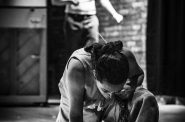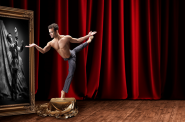“La Boheme” goes dancing
Michael Pink (cough) makes a pretty good (cough) ballet out of (cough) Puccini's "La Boheme." Through Sunday at Uihlein Hall.

Luz San Miguel and David Hovhannisyan, as Mimi and Rodolfo falling for love. Mark Frohna photo for the Milwaukee Ballet.
Nothing much happens in Puccini’s La Bohème. Boy meets girl, girl dies. In between, artistic fellows and the loose women in their orbit flirt and fall in and out of love repeatedly. Lots of talking.
Michael Pink did a pretty good job of making La Bohème expressively kinetic in his new setting, which the Milwaukee Ballet premiered Thursday night. He devised all manner of comic horseplay in the garret for Rodolfo, Marcello, Colline and Schaunard. David Hovhannisyan, Timothy O’Donnell, Marc Petrocci and Ryan Martin, respectively, timed the choreographed setting of the table crisply and in their body language conveyed the distinct personalities and the pecking order among the four pals.
They also defined this ballet immediately as a dance piece and not as a mime show. Pink has a way of winding information into his dances and rarely stops the dancing to move the plot along in gesture only. Pink’s ballet brims over with dancing, among the characters in private, at parties and in the streets of Paris. In the Cafe Momus scene, for example, a bounding Barry Molina, as a Father Christmas sort of toy vendor, bounds about on springy legs. A troop of children line up behind and imitate him. Of course it’s all choreographed, but in the whirling crowd it feels wonderfully spontaneous.
Later, the vibrant Annia Hidalgo, as Musetta, crashes in like a meteor. Every man’s eye turns to Hidalgo, her black lace evening gown and Black Swan bravura. Of course she duped her wealthy escort and ended up with old flame Marcello, and thus began a stormy, evening-long relationship with O’Donnell. Each was very good, and they were very good together, with contact both combative and sensual.
Dancing – again, not mime – replaced the conversational duets in the opera. In these pas de deux, Pink followed the lilt, arc and rhythm of Puccini’s melodies and ignored the beat. So the dancing plays out almost as cursive writing, rendered in the speech rhythms that underlie the music. This strategy turned out to be convincing in the important duets between Luz San Miguel (playing Mimi) and Hovhannisyan, O’Donnell and Hidalgo and between Hovhannisyan and O’Donnell.
The crucial scene in both the opera and the ballet is the Mimi/Rodolfo falling-in-love duet Act 1. Pink’s design and the dancers’ execution were very smart, here. Because of the speech rhythm, the dancing, technical as it was with all manner of complex lifts, felt like prose, like a conversation, and not a formal one. What begins playfully turns ardent in a convincing way.
I like the way Pink brings that duet back throughout the ballet, in variations that are combative, affectionate and, in the final scene, touchingly small and fragile. This lent the piece some form. Pink was especially clever in the tavern scene, when he assigned essentially the same steps to Hidalgo and O’Donnell as they fought even as San Miguel and Hovhannisyan reconciled beside them.
The story unfolds fairly clearly in the dancing, but a few points will mystify those who don’t know the opera. One hint: Colline dances with his coat because he intends to pawn it to pay for medicine for the consumptive Mimi. If Marc Petrocci were singing the words, you’d know that he’s fond of his coat. Otherwise, it seems absurd.
And speaking of consumption and absurdity: Mimi, please – die already. With one exception, that thought has occurred to me at some point in every La Bohème I’ve witnessed over the decades, and it occurred to me again Thursday. This is ballet; silent, right? Well, San Miguel coughs in Scene 1 and frequently throughout the show. The noise, predictably, prompts the audience into coughing fits, undercuts the plausibility of such a character dancing, is just plain annoying and, most important, breaks the silent spell of the ballet. San Miguel could easily have conveyed the illness with a silent shake of the shoulders and a hand to the mouth. Pink made a mistake, there.
Otherwise, this is a thoughtful, engaging retelling of a familiar tale. Paul Daigle’s 1950s costumes and Rick Graham’s ingenious, mobile, silhouette set evoke French New Wave, and David Grill’s lighting is subtle and atmospheric. Sill’s arrangement is beautiful and excellent for dancing, and the Milwaukee Ballet Orchestra played it very well indeed.
La Bohème repeats at 7:30 p.m. Friday and Saturday and at 1:30 p.m. Sunday, Oct. 19-21, at Marcus Center Uihlein Hall. Tickets start at $30 online, or call 414 902-2103 or the Marcus Center box office, 414 273-7206.
Nicole Teague will play Mimi and Alexandre Ferreira will play Rodolfo on Friday and Sunday.
Don’t miss anything! Bookmark Matthew Reddin’s TCD Guide to 2012-13, and check Danielle McClune’s On Stage weekly guide every Tuesday.
Dance
-
New Riverwest Company, Production Impresses
 Feb 10th, 2020 by Brendan Fox
Feb 10th, 2020 by Brendan Fox
-
Milwaukee Ballet Show Remakes History
 Feb 10th, 2020 by Catherine Jozwik
Feb 10th, 2020 by Catherine Jozwik
-
Ballet Does Free Production of ‘Nutcracker’
 Dec 20th, 2019 by Richard Davis
Dec 20th, 2019 by Richard Davis






















Last night was so beautiful, the program explained most of the opera…story
But we all knew she would die, couldn’t help but think it got a bit lengthy.